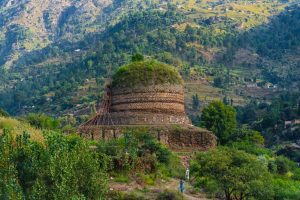
Karakoram Highway, the eighth wonder of the world
October 26, 2021
Lahore Fort – Mughal Architecture
October 26, 2021 The stupa of Amluk Dara is the oldest known stupa of Gandhara civilization located about 2kilometers on the north of Nawagai village in the beautiful small valley of Amluk Dara in the Swat Valley, Pakistan. The monastery can be clearly seen from surrounding areas, naturally sheltered by the great Mount Elum. The main stupa stands on a heavenly square plinth with base embellishment in the torus and Scotia design estimates 34 meters in measurement. The square shape base plinth stands to a height of 4 meters.
The stupa of Amluk Dara is the oldest known stupa of Gandhara civilization located about 2kilometers on the north of Nawagai village in the beautiful small valley of Amluk Dara in the Swat Valley, Pakistan. The monastery can be clearly seen from surrounding areas, naturally sheltered by the great Mount Elum. The main stupa stands on a heavenly square plinth with base embellishment in the torus and Scotia design estimates 34 meters in measurement. The square shape base plinth stands to a height of 4 meters.
The stupa was first discovered in 1926 by Hungarian British archaeologist, Sir Aurel Stein whereas it was first documented by Italian Giuseppe Tucci in 1956 and later Italian archaeologist, Domenico Faccena carried out research studies on the site in the 60s and 70s. However, in 2012, a complex attached to the stupa was discovered by the Italian Archaeological Mission under the Archaeology Community Tourism project that further increased the importance of the site and opened new horizons for history and tourism.
The ruins of the monastery, stupas, and miscellaneous remains can still be seen on the eastern and northern side of the main stupa. They are mostly disturbed by illegal diggers. Stein recorded several coins from the Kushanas to the Turki Shahis dating from the 2nd to 7th century A.D. In 1938, the site was investigated by Barger and Wright. They recovered some Gandhara sculptures but did not investigate further to ascertain the exact period of the site.
The dome of the stupa is still in its original form and has been destroyed unlike most of the other stupas. The king of Swat has built the stupa to store his relics of Buddha. This monument is among the remains of the monuments from the Buddhist period which number up to a thousand
